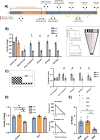Running towards amblyopia recovery
- PMID: 32728106
- PMCID: PMC7391754
- DOI: 10.1038/s41598-020-69630-7
Running towards amblyopia recovery
Abstract
Amblyopia is a neurodevelopmental disorder of the visual cortex arising from abnormal visual experience early in life which is a major cause of impaired vision in infants and young children (prevalence around 3.5%). Current treatments such as eye patching are ineffective in a large number of patients, especially when applied after the juvenile critical period. Physical exercise has been recently shown to enhance adult visual cortical plasticity and to promote visual acuity recovery. With the aim to understand the potentialities for translational applications, we investigated the effects of voluntary physical activity on recovery of depth perception in adult amblyopic rats with unrestricted binocular vision; visual acuity recovery was also assessed. We report that three weeks of voluntary physical activity (free running) induced a marked and long-lasting recovery of both depth perception and visual acuity. In the primary visual cortex, ocular dominance recovered both for excitatory and inhibitory cells and was linked to activation of a specific intracortical GABAergic circuit.
Conflict of interest statement
The authors declare no competing interests.
Figures




References
Publication types
MeSH terms
LinkOut - more resources
Full Text Sources
Medical

